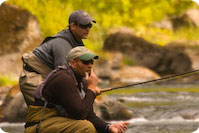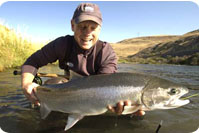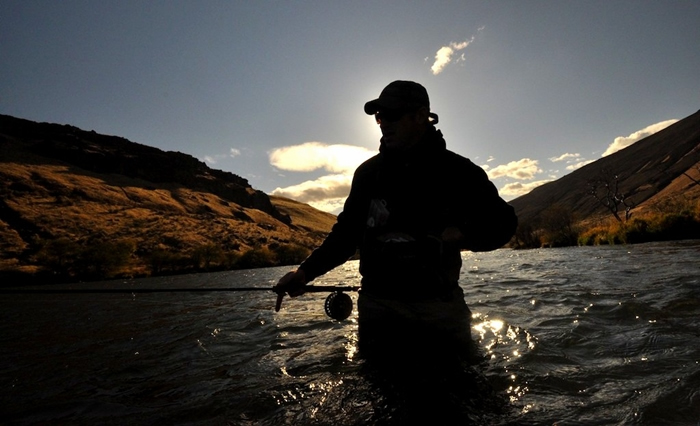|
Photo: Rob Elam
So you are fishing well. Your luscious looking steelhead fly is probing the river and you are thinking that the tug is coming at any second. Are you really ready for this? The bite, that is. When it finally comes, will you pin that fish or will the hook simply fall away into river shrouded obscurity?
If you have spent any time swinging flies for steelhead, you’ve likely heard the whole deal about how you don’t want to set the hook immediately – that it’s not like trout fishing with a dry. This is true. History says that hookup success is best achieved by allowing the fish to first take the fly, and then turn with the fly before any serious pressure is applied to the line. By allowing the fish to turn, it is more likely that the hook will find purchase into the fleshy corner of the mouth and the angle of the fish moving away from the plane of your line will help it seat. I used to tell my clients to think about steak dinners. Let them chew on it a little bit first.
This is all fine and dandy, but how do you do this? How do you make sure you give the fish some line to run with before setting up on her? Well there are different ways to accomplish this and please keep in mind that not all steelhead anglers agree on this issue. Or they may simply resolve to tell say, Whatever works best for you, and this is one thing I can completely agree on.
1. Carry a Loop After the cast, your initial mend, and before your fly start swinging across the current line, you pull some fly line back through the rod tip and pinch it with your finger against the cork or the rod butt. The line sags from the reel down towards the water and then back up to your finger. This is the amount of line that the fish will take before it hits fly reel tension. The length of the loop all depends on the angler preference, however, a loop between 2 – 3 feet is pretty typical for dry line fishing. The general thought here is to lengthen the loop in faster water and more ideal temperatures and shorten the loop while fishing deeper or in less ideal water temps/sunlight. Some anglers I know who fish loops with dry lines, fish only a very small loop (10-12 inches) or no loop at all while fishing sink tips.
It’s really important however, that you are conscious of how tightly you are pinching the line. You want it just barely pinned, so that when the fish takes, it slips easily to the fish. Think about feeding the fish. Give, not take away. After the fish takes the fly and turns, your loop is now gone and there is building tension on the reel, that is the time to set the hook. If it was an aggressive take, then all that is needed is a gentle lifting of the rod (45-80 degree angle from river surface) off your downstream shoulder towards YOUR shoreline. If it was a subtle take, then a little more force will help to seat the hook. Remember, if a fish is moving away from you and you set too hard, you risk breaking off the fly or pulling the hook free.
2. Fish with a high rod tip The idea here is that the slack, or sag of line from the rod tip to the water, provides ample give to the fish when it grabs the fly. If the angler also lowers his rod tip on the initial take, this will increase the amount of slack provided. Some folks prefer this method, however I see a couple problems here. First, you lose sensitivity. Tension to the fly is decreased during the presentation. With slack added between your reel and your fly, it is more difficult to detect subtle takes. Secondly, you lose control over the presentation. I like to gradually lower my rod tip as the swing proceeds, so as to use those currents to steer the fly towards shore. At times, however, it helps to add a downstream belly to the drift so that the fly can finish up strong on the inside. But at any rate, usually by the end of the swing, my rod tip is down to the river, with deep tension in the line to my reel.
3.Fish a light drag In this case, you are fishing your line tight to the reel; no loop of line, and you are free to fish your rod tip at any height off the water you choose. When the fish takes, your drag is set light enough to release line on its own. Not too light. Not too tight. Finding the perfect tension here can take some fiddling, but there should be very little resistance when the fish comes to the fly. Think about those weary fish that lazily follow and lip the fly. For these fish especially, it is really important that line peels off the reel and follows the hook. However, you must be careful that the drag is tight enough so as not to free-spool.
Once the fish has the fly and has turned with it, allow line to run off the reel for a period of time before tightening up on the line between your fingers and rod butt. Uttering a phrase like, “God Save the Queen,” or counting up to 2 or 3 “One Thousands” before tightening up on the line is usually a good time frame. But here’s where you can fine tune your timing: By using your fingers, you can tailor the amount of pressure you put on the line and gauge how much purchase the hook has to the fish. If you are feeling sturdy pressure while line is still slipping between your fingers and your rod, then you can start to apply more pressure on the line against the cork and ease into a hook set. Not all takes are the same however. Sometimes they smash it and before you know what happened, the fish is already 10 feet into your running line. Sometimes it’s extremely light. The main thing to remember is to afford that fish line to work with and set gradually when you feel sturdy pressure.
Which technique is best? Well, it all depends on personal preference. I was once a Loop Man, however I have gotten away from this over the past few years. Now I like to fish the fly tight to my fly reel on a light drag. I actually prefer a click-pawl drag design for steelhead fishing because I like the steady, dependable, one-tension (light) drag setting. However, if you have disc-drag reel that stays true even at light settings, then you should be good to go.
I like fishing tight to the reel because I think fishing a loop affords too much slack after first contact with the fish. Too much wiggle room. Too much room to spit the fly. Not enough tension to keep the hook seated. The fish takes, and then there is a window of time where the hook becomes a victim to currents and movements of the fish. I think many subtle-take-fish are lost at this point when a loop is dropped and the fish does not move away from you quickly enough, or at an angle that helps to seat the hook. Sometimes these fish aren’t turning at all, but rather sinking back down into the depths of the river after nipping at the fly. So, in order to afford just enough tension, I fish it straight to the reel with a finger touching the running line, so as to detect any funny business. Furthermore, this slight touch up under the running line, in this fly- to- reel connection, affords far greater sensitivity than if you have it pinned against the rod.
However, fishing with a light drag means that you must fight the fish by using your palm or fingers to slow down the reel spool; or that you must tighten up the drag during the fight. For those who would rather pick one drag setting with some stopping power and not have to fiddle with it during the fight, then the Loop technique, or High Rod technique might be best.
Generally speaking, all these techniques work, however it is up to the operator to get used to them and perform them effectively. For many who are new to steelheading, fishing directly to the reel is often a simpler way to go, as there is less to think about upon initial impact.
|




